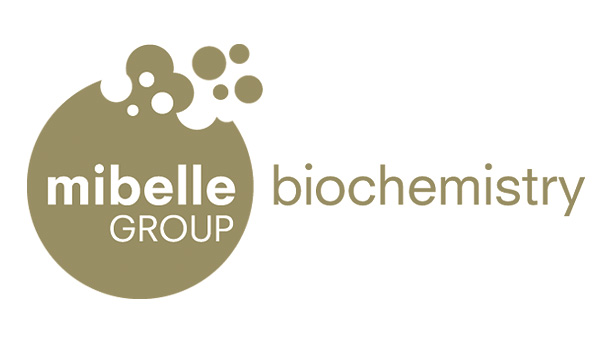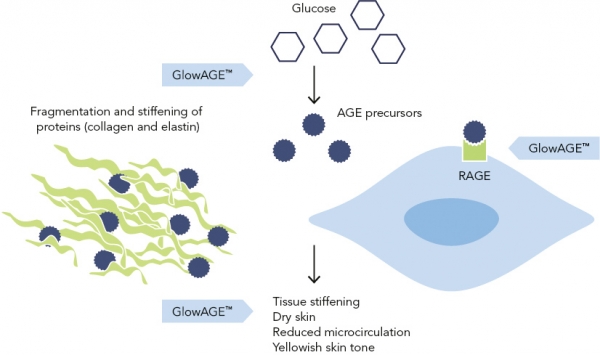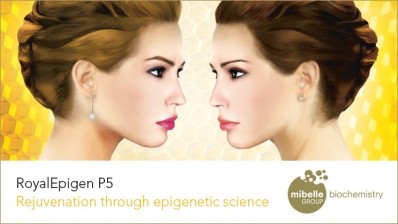Promotional Features
Glycation - The bitter effects of too much sugar in the skin
Glycation is a well-known skin aging factor and thus it is highly important to understand it in order to counteract this skin aging process. Just recently, its relevance was again underlined by the renowned IFSCC Henry Maso award 2020 being awarded to Dr. Ka-Heng Lee for his glycation research.
But what is glycation exactly and how does it affect our skin? Glycation is a chemical process that happens throughout our body. During glycation, proteins and reducing sugars, for example glucose, form a covalent bond. This happens spontaneously without the help of any enzymes. Glycation is an important aspect of frying and bread baking as it is responsible for the browning process. Due to the much lower temperatures in our bodies, the glycation process is much slower. However, over many years, an inevitable accumulation of the so-called advanced glycation end products (AGEs), cross-linked bundles of proteins and sugars, occurs. This accumulation negatively affects cellular processes as the cross-linked proteins cannot carry out their intended function. Whilst glycation is a natural and universal process that affects aging tissues, it is exacerbated by UV irradiation and an increased consumption of sugar.
The AGEs that are formed by the glycation reaction do not just hinder normal protein activity and cellular function. AGEs also bind to a specific receptor for advanced glycation end products (RAGE) that is present on the surface of many cell types, including our skin cells. And this binding of AGEs to RAGE causes an inflammatory response. AGEs also cause the formation of free radicals that lead to further RAGE upregulation, and UV exposure additionally contributes to RAGE production. This results in a vicious circle of chronic inflammation and tissue damage.
The skin is significantly affected by glycation. Collagen, which is the most abundant protein in our body with a very slow turnover rate, is crosslinked with sugar molecules during the aging process. Extensive crosslinking of collagen and elastin through the glycation reaction leads to a stiffening of these normally elastic fibers in the dermis, which reduces the skin’s elasticity. As the initial products of the glycation reaction are highly reactive and susceptible to oxidation and fragmentation, a high level of glycation will lead to collagen fragmentation in the skin. These fragments can further react with other proteins and contribute to an accelerated AGE formation. Additional consequences of glycation are dry skin, reduced microcirculation, and a yellowish skin tone as a result of the color of the AGEs.
It is therefore important to counteract the formation of AGEs in the skin. While glycation happens spontaneously, the removal of AGEs will require the help of an enzymatic machinery. Consequently, this machinery needs to be activated in order to recycle the AGEs already present in the skin for a rejuvenation effect.
Ziziphus spina-christi, which is also known as jujube, is a thorny evergreen shrub that can also grow into a tree measuring up to 20 m in height. It is cultivated for its fruits and also in order to provide shade in northern Africa, throughout the Middle East, and in northern India. Ziziphus spina-christi is very tolerant to high temperatures and grows in arid regions where dry seasons can last up to 10 months. This drought-resistant plant can even be found in desert areas where there is only 100 mm rainfall annually. The leaves of Ziziphus spina-christi were used throughout history as herbal remedies against wounds, skin infections, insomnia, and diabetes. In addition to the historic uses, modern medicine discovered antibacterial, antioxidative and interestingly, also antidiabetic properties of Ziziphus spina-christi leaves.
Mibelle Biochemistry collaborated with a research group from the University of Basel to elucidate the composition of Ziziphus spina-christi leaves from different countries and a detailed phytochemical profiling was published in 2017 in the peer-reviewed journal Phytochemistry. From the leaf extract, the novel active ingredient GlowAGE was developed. In vitro studies have shown that GlowAGE not only prevents the formation of AGEs, but it also helps to boost the cellular machinery to recycle AGEs that have already been formed. In a clinical study, GlowAGE reduced the appearance of wrinkles, displayed an anti-yellowness effect and counteracted collagen fragmentation in the skin.
To summarize, glycation is a slow and steady process that greatly contributes to skin aging. Counteracting glycation is one of the crucial measures that need to be undertaken to slow down the aging process.
To help in this important task, GlowAGE:
• Prevents and reverses glycation
• Brings radiance to sallow skin
• Reduces wrinkles and smoothes the skin
• Features collagen-restoring power








